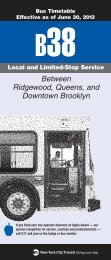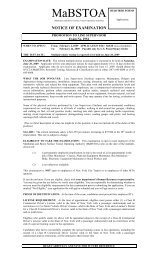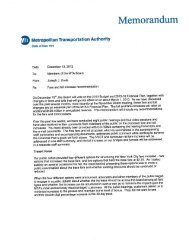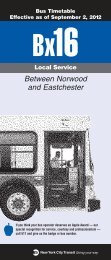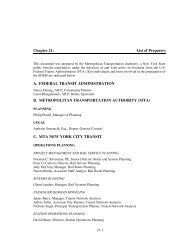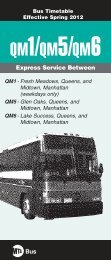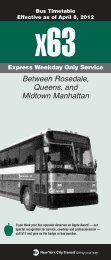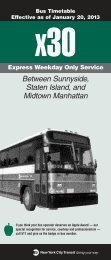Greening Mass Transit & Metro Regions: The Final Report - MTA
Greening Mass Transit & Metro Regions: The Final Report - MTA
Greening Mass Transit & Metro Regions: The Final Report - MTA
Create successful ePaper yourself
Turn your PDF publications into a flip-book with our unique Google optimized e-Paper software.
TRANSFORMATIONAL RECOMMENDATIONS<br />
Recommendation 1. Quantify and Track the <strong>MTA</strong>’s Materials Flow<br />
<strong>The</strong> Commission calls on the <strong>MTA</strong> to develop a unified baseline of the materials flow across all agencies. This baseline<br />
should facilitate the development of a system for tracking and managing systemwide materials flow information, including<br />
procurement, waste disposal, and recycling. <strong>The</strong> system should eventually connect <strong>MTA</strong> procurements at one end with<br />
<strong>MTA</strong> waste recycling and disposal at the other, treating procurement, waste management, and recycling as parts of an<br />
integrated whole. <strong>The</strong> procurement goal should be to classify, green, lighten, minimize, and recapture a significant percentage<br />
of the <strong>MTA</strong>’s annual materials procurements. On the disposal side, the goal should be to quantify and track <strong>MTA</strong> waste in<br />
four categories: (1) customer-generated waste, (2) process-generated waste, (3) construction and demolition debris, and<br />
(4) office waste. By developing consistent metrics and steadily merging the procurement and disposal sides, the <strong>MTA</strong> will<br />
evolve a valuable system for reducing costs, recapturing materials, and greening its entire operation.<br />
Recommendation 2. Green the <strong>MTA</strong>’s Procurements and Operating Budget<br />
To begin action on Recommendation 1, the <strong>MTA</strong> should review the nearly $2 billion spent annually on material and service<br />
procurements, identifying purchase categories that can be greened, reduced, or recaptured. To further systemize its present<br />
green programs, the <strong>MTA</strong> should plan to unify policies and practices as recommended above. <strong>The</strong> plan should incorporate<br />
ongoing programs, while further specifying green materials, purchasing practices, performance standards, and contracts.<br />
<strong>The</strong> All-Agencies Procurement Council and the new<br />
<strong>MTA</strong> Businesses Services Center are natural places<br />
to begin this process. <strong>The</strong> plan should include:<br />
Developing LCA for <strong>Transit</strong> Systems<br />
• A unified electronic system for gathering data<br />
Lifecycle Analysis (LCA) assesses products all the way from raw materials through<br />
for convenient procurement tracking and an annual<br />
manufacturing, transportation, and disposal to determine the total environmental<br />
Sustainability Progress <strong>Report</strong>. Wherever possible, the<br />
and CO2 effects. An LCA process can be found in the subsections of the ISO 14000<br />
plan should convert projects into units of “carbon avoid- environmental management standards. ISO 14040:2006 provides the definiance,”<br />
using the SROI model presented in this report.<br />
tions, principles, and framework for LCA. ISO 14044:2006 specifies requirements<br />
and guidelines. <strong>The</strong> ISO standards offer a good starting point for the <strong>MTA</strong>'s LCA<br />
• An <strong>MTA</strong> Environmental Champions Program, in which<br />
program. Additionally, a survey of transit agencies undertaken by the Commission<br />
each <strong>MTA</strong> facility or department designates a volunteer<br />
identified a new transit-based LCA plan with 14 goals introduced by the Toronto<br />
Environmental Champion responsible for sustainability<br />
<strong>Transit</strong> Commission (TTC) in July 2008. <strong>The</strong> <strong>MTA</strong> is reviewing both the ISO 14000<br />
education, outreach, and motivation. This program could<br />
plans and the new TTC plan to begin developing an LCA plan that can be used by<br />
be coupled with employee incentives, including awards<br />
other transit agencies as well.<br />
for green ideas and achievements.<br />
Recommendation 3. Institute a Systemwide<br />
Green Lifecycle Analysis (LCA) System to Manage Materials from Procurements Through Disposal<br />
In accordance with the previous recommendation, the Commission suggests that the <strong>MTA</strong> institute a Lifecycle Analysis<br />
(LCA) system to manage materials from procurements through disposal. This LCA system will allow the <strong>MTA</strong> Agencies<br />
to accurately price and justify green procurement opportunities. <strong>The</strong> LCA would rationalize costs over the full lifecycle<br />
of the materials, products, or services, taking account of designated sustainability benefits. Examples include the lower<br />
maintenance cost associated with LED lighting or the lower CO2 output from rail shipping of excavation soil. <strong>The</strong> LCA<br />
plan should include:<br />
• Software models for efficient tracking and analysis, along with examples of current LCA programs. <strong>The</strong> <strong>MTA</strong> could use<br />
an off-the-shelf quantitative lifecycle software program (such as CMLCA, BEES, and others) or environmental management<br />
systems (such as the ISO 14044/14048 standards) to develop its own LCA system. Currently NYCT's CPM is ISO<br />
14001 Certified.<br />
• Develop an LCA Scoring System: Environmentally Preferable Purchasing (EPP) and Product Evaluation Model. <strong>The</strong> model<br />
would include six procedural steps: (1) compare off-the-shelf products categorized by product end-uses on a lifecycle basis,<br />
(2) determine product categories and subcategories, along with weighted decision criteria, (3) identify candidate products<br />
for the EPP list evaluation, using a range of screening tools, (4) assign positive procurement scores within the EPP+ lists,<br />
(5) gather information and score candidate products, and (6) promote the use of EPP+ lists.<br />
• Develop a method for identifying and quantifying cost savings – both dollar savings and carbon avoidance savings –<br />
from green initiatives.<br />
45



